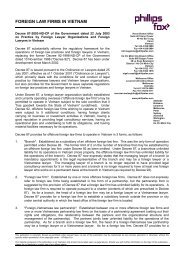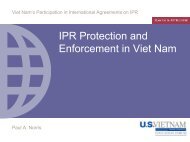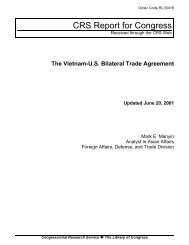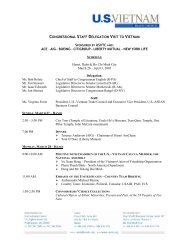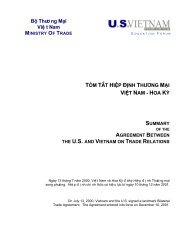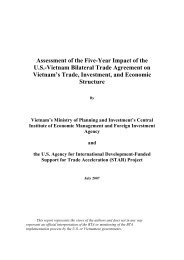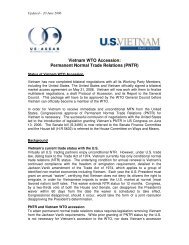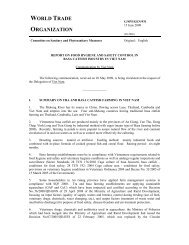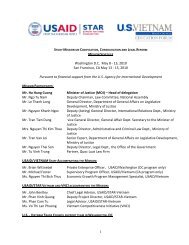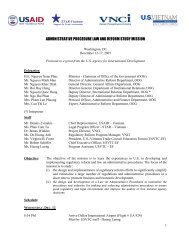Return periods considered 18In this study, for each of the cities, flood risk wasestimated for events of different <strong>in</strong>tensities or returnperiods, namely a 1-<strong>in</strong>-10-year, 1-<strong>in</strong>-30-year, <strong>and</strong>1-<strong>in</strong>-100-year floods <strong>in</strong> the base year <strong>and</strong> <strong>in</strong> 2050. 19This was based on a statistical evaluation of historicstorm events that allowed the assignment of probabilitiesto extreme precipitation events 20 associatedwith the floods.Hydrological model<strong>in</strong>g undertaken toestimate flood<strong>in</strong>g under different scenariosThe hydrological models simulate the movementof water on l<strong>and</strong> after it falls as precipitation. 21 Akey <strong>in</strong>itiat<strong>in</strong>g <strong>in</strong>put parameter for such model<strong>in</strong>gis precipitation (derived for each city from thedownscal<strong>in</strong>g analysis). The manner <strong>and</strong> tim<strong>in</strong>g ofthe precipitation’s arrival <strong>in</strong> the rivers is driven bythe precipitation <strong>in</strong>tensity <strong>and</strong> duration, the terra<strong>in</strong>slopes <strong>and</strong> l<strong>and</strong> use cover (which can drive <strong>in</strong>filtration<strong>and</strong> evapotranspiration), <strong>and</strong> the channelcharacteristics. Computer models, <strong>in</strong> which the relevant<strong>in</strong>formation is digitized, allow the otherwisedaunt<strong>in</strong>g calculation of the movement of waterthrough the watershed <strong>and</strong> channel. In additionto the <strong>in</strong>put parameter of precipitation <strong>and</strong> spatialdata affect<strong>in</strong>g the flow of the runoff, the boundary(or tail-water) conditions where the flood exits asystem <strong>in</strong>to the sea can create a backwater effect,rais<strong>in</strong>g the water level profile of the river upstreamfrom the sea <strong>and</strong> <strong>in</strong>creas<strong>in</strong>g the overbank spillage<strong>and</strong> flood <strong>in</strong>undation levels. Storm surge can alsocause the movement of the water upstream from thesea <strong>in</strong>to the <strong>coastal</strong> cities. The hydrometeorologicalmodels were designed to model these <strong>in</strong>teractions<strong>and</strong> are based on general pr<strong>in</strong>ciples outl<strong>in</strong>ed below(Box 2.3).Manila <strong>and</strong> Bangkok applied commerciallyavailable software to develop the hydrologic models<strong>and</strong> HCMC utilized hydrologic models that hadalready been developed <strong>and</strong> calibrated by the governmentfor their catchment area. Outputs from theHCMC hydrologic models can also be l<strong>in</strong>ked to commercialor open-sourced software models to ref<strong>in</strong>e<strong>in</strong>undation <strong>in</strong>formation. Typically a comb<strong>in</strong>ationof models was used <strong>in</strong> the city studies (Table 2.2).Large watersheds with many sub-bas<strong>in</strong>s, reservoirs,diversions, etc. have necessarily complexmodels describ<strong>in</strong>g the water transfer with<strong>in</strong> thebas<strong>in</strong>. For the Chao Phraya River Bas<strong>in</strong>, for example,a complex comb<strong>in</strong>ation of models neededto be <strong>in</strong>terl<strong>in</strong>ked to accurately simulate flood<strong>in</strong>g <strong>in</strong>Bangkok. The schematic shown <strong>in</strong> Figure 2.1 belowshows the <strong>in</strong>terconnectedness of ra<strong>in</strong>fall-runoff (onthe upper watersheds), reservoir <strong>and</strong> river rout<strong>in</strong>g,<strong>and</strong> flood rout<strong>in</strong>g (2D). The complexity has an impacton the time <strong>and</strong> depth of analysis. For example,a simulation run for Bangkok with one set of <strong>in</strong>putparameters took 24 hours of computer time, <strong>and</strong> thestudy required over 30 simulation runs not count<strong>in</strong>gthe runs required for calibration. HCMC used asimulation model that had been previously developed<strong>and</strong> calibrated by the government. Manila’shydrologic models were far simpler <strong>and</strong> the periodof flood<strong>in</strong>g modeled was only a few days, so thelength of the simulation runs <strong>in</strong> terms of computertime was far shorter than for Bangkok.Calibration of hydrometeorological modelsAs noted above, to ensure the accuracy of the models,rigorous calibration is necessary. The process requiressignificant trial <strong>and</strong> error <strong>in</strong> gett<strong>in</strong>g the modelto accurately reflect historic movements of floods asrunoff, through river channels <strong>and</strong> overl<strong>and</strong> floodevents. In Figure 2.2 below for Manila, the dottedl<strong>in</strong>e shows the observed discharge <strong>and</strong> the blue l<strong>in</strong>e18This refers to the recurrence <strong>in</strong>terval or the return periodof a flood <strong>and</strong> is an estimate of the time <strong>in</strong>terval betweentwo flood events of certa<strong>in</strong> <strong>in</strong>tensity. It is a statistical measureof the average recurrence <strong>in</strong>terval over a long period oftime <strong>and</strong> is the <strong>in</strong>verse of the probability that the event willbe exceeded <strong>in</strong> any one year. For example, a 10-year floodhas a 1 / 10 = 0.1 or 10 percent chance of be<strong>in</strong>g exceeded<strong>in</strong> any one year <strong>and</strong> a 50-year flood has a 0.02 or 2 percentchance of be<strong>in</strong>g exceeded <strong>in</strong> any one year. Thus, a 100-yearflood has a 1 percent chance of occurr<strong>in</strong>g <strong>in</strong> any given year.However, as more data becomes available, the level of the1/100 year flood will change.19HCMC restricted its analyses to 1-<strong>in</strong>-100 <strong>and</strong> 1-<strong>in</strong>-30-yearfloods.20An extreme event that causes flood<strong>in</strong>g could be fromextreme 24-hour ra<strong>in</strong>fall on a small watershed, a high seasonalra<strong>in</strong>fall on a large watershed, or a typhoon or cyclone<strong>and</strong> associated storm surge.21Storm surge <strong>and</strong> SLR have been <strong>in</strong>corporated <strong>in</strong>to themodels as boundary tailwater conditions for the hydrologicmodels.10 | <strong>Climate</strong> Risks <strong>and</strong> Adaptation <strong>in</strong> <strong>Asian</strong> Coastal Megacities: A Synthesis Report
Box 2.3 ■ Some Basic Pr<strong>in</strong>ciples for Hydrological Mapp<strong>in</strong>gHydrologic models use a mass balance approach<strong>in</strong> develop<strong>in</strong>g the empirical relationships, where<strong>in</strong>the volume of <strong>in</strong>flow (or precipitation) m<strong>in</strong>usthe losses equals the volume of outflow. For thera<strong>in</strong>fall-runoff relationship, the ra<strong>in</strong>fall excess,which appears as runoff <strong>in</strong> the river channels, isequal to the precipitation m<strong>in</strong>us the evaporation,<strong>in</strong>filtration, depression storage, <strong>and</strong> <strong>in</strong>terceptionas depicted <strong>in</strong> the figure below. The empiricalmodels must be calibrated aga<strong>in</strong>st observedevents <strong>in</strong> order to provide useful estimates.The empirical relationships generallycapture physical <strong>in</strong>formation (e.g., l<strong>and</strong> use<strong>in</strong>formation, soil types, antecedent ra<strong>in</strong>fall,area, <strong>and</strong> gradients for ra<strong>in</strong>fall-runoff models,or river gradient, cross-sections, <strong>and</strong> roughnessRATE, DEPTH PER UNIT TIMEestimates for river-channel rout<strong>in</strong>g models) that are used with parameters to generate the <strong>in</strong>put-output relationships. The parameters are adjusted<strong>in</strong> an iterative approach to obta<strong>in</strong> the best fit to the actual data as part of the calibration process.Source: American Society of Civil Eng<strong>in</strong>eers, Hydrology H<strong>and</strong>book (1996).INFILTRATIONDEPRESSION STORAGE+ INTERCEPTIONCONSTANT INTENSITY RAINFALLTIMERAINFALL EXCESSEVAPORATIONTable 2.2 ■ Summary of City CaseStudy Hydrologic Model<strong>in</strong>gCity StudyBangkokHCMCManilaHydrologic models usedRa<strong>in</strong>fall-runoff model<strong>in</strong>g of the upper Chao Phrayawatershed entailed divid<strong>in</strong>g the bas<strong>in</strong> <strong>in</strong>to 15 subbas<strong>in</strong>s<strong>and</strong> us<strong>in</strong>g NAM model; the MIKE FLOOD softwaremodel was used for the lower Chao Phraya coupl<strong>in</strong>g theMIKE 11 <strong>and</strong> MIKE 21 for 1D <strong>and</strong> 2D flows.*Ra<strong>in</strong>fall <strong>in</strong> the upper watershed of the Saigon <strong>and</strong>Dong Nai rivers are captured by the Dau Tieng <strong>and</strong> TriAn reservoirs; outflows from these were modeled bythe Southern Institute of Water Resource <strong>and</strong> Plann<strong>in</strong>gbased on historical (2000) flood<strong>in</strong>g. The HYDROGISmodel was used for the model<strong>in</strong>g of HCMC. It has beenspecifically designed <strong>and</strong> calibrated by Vietnam’sM<strong>in</strong>istry of Natural Resources <strong>and</strong> Environment’sInstitute of Meteorology, Hydrology <strong>and</strong> Environment<strong>and</strong> models both 1D <strong>and</strong> 2D flows.The NAM software was used to model the ra<strong>in</strong>fall-runoffrelations l<strong>in</strong>ked to the MIKE FLOOD; MIKE 11 <strong>and</strong> 21were used to model floods <strong>in</strong> Manila.shows the simulated discharge us<strong>in</strong>g the model<strong>and</strong> the actual <strong>in</strong>put precipitation data, <strong>in</strong>dicat<strong>in</strong>gthe robustness of the model. This type of “groundtruth<strong>in</strong>g”was done for the hydrological model<strong>in</strong>g<strong>in</strong> the Bangkok <strong>and</strong> HCMC studies as well.Figure 2.1 ■ HydrometeorologicalModel Schematic forChao Phraya WatershedNote: * When the water is flow<strong>in</strong>g <strong>in</strong> a channel, the model is frequently referred to asone-dimensional (1-D) <strong>and</strong> overl<strong>and</strong> flow models are referred to as two-dimensional(2-D) models.Source: Panya Consultants.Methodologies for Downscal<strong>in</strong>g, Hydrological Mapp<strong>in</strong>g, <strong>and</strong> Assess<strong>in</strong>g Damage Costs | 11



